The lower body cycle of Pawanmuktasana sequentially opens the joints, from the toes to the hips. People with poor circulation in the legs will benefit from this simple practice.
 1) Toe Bending: The six lower body meridians all begin or end in the toes. This simple practice begins to awaken the flow right at the tips of the body. Sit with your legs extended and your hands behind you on the floor. (If you have tight hamstrings or sciatica, sit on a cushion.) Wave your toes back and forth ten times. Move slowly and hold the pose for a few seconds, keeping the ankles relaxed.
1) Toe Bending: The six lower body meridians all begin or end in the toes. This simple practice begins to awaken the flow right at the tips of the body. Sit with your legs extended and your hands behind you on the floor. (If you have tight hamstrings or sciatica, sit on a cushion.) Wave your toes back and forth ten times. Move slowly and hold the pose for a few seconds, keeping the ankles relaxed.

 2) Ankle Bending: Remain with legs straight and flex the feet at the ankles, and then extend them. Move the feet back and forth ten times. We are now beginning to free up the ankle joints, through which all the lower meridians run. Again move slowly, and hold each position for a few seconds.
2) Ankle Bending: Remain with legs straight and flex the feet at the ankles, and then extend them. Move the feet back and forth ten times. We are now beginning to free up the ankle joints, through which all the lower meridians run. Again move slowly, and hold each position for a few seconds.

 3) Ankle Rotation: Since some meridians run through the side of the ankles, simply bending the ankles doesn’t remove all blockages. Now, we circle the ankles. Keeping the knees from moving, and the feet apart, move the right foot in a circle: ten times in one direction and then ten times in the other direction. Do the same with the left foot. Next, bring the feet together and circle both feet, ten times, with both feet moving in same direction. Switch direction, and do ten more. Finally, separate the feet so the big toes can just touch, and rotate the feet in opposite directions ten times. Then switch and do the reverse direction for each foot ten times. [1]
3) Ankle Rotation: Since some meridians run through the side of the ankles, simply bending the ankles doesn’t remove all blockages. Now, we circle the ankles. Keeping the knees from moving, and the feet apart, move the right foot in a circle: ten times in one direction and then ten times in the other direction. Do the same with the left foot. Next, bring the feet together and circle both feet, ten times, with both feet moving in same direction. Switch direction, and do ten more. Finally, separate the feet so the big toes can just touch, and rotate the feet in opposite directions ten times. Then switch and do the reverse direction for each foot ten times. [1]
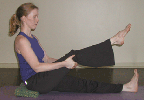
 4) Knee Bending: Hold under the right thigh and lift the leg in the air. Alternately straighten, and then bend the knee so that the heel comes close to the back of the thigh. Do this ten times. Repeat on the other side.
4) Knee Bending: Hold under the right thigh and lift the leg in the air. Alternately straighten, and then bend the knee so that the heel comes close to the back of the thigh. Do this ten times. Repeat on the other side.
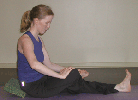 5) Ankle Cranking: A deeper rotation for the ankles comes when they are cranked by hand. Bend the right leg and rest the ankle on the left knee. Use your left hand and take hold of the foot. Rotate the ankle ten times in each direction. A nice option is to interlace your fingers with the toes and spread them while you crank. Now, do the other ankle.
5) Ankle Cranking: A deeper rotation for the ankles comes when they are cranked by hand. Bend the right leg and rest the ankle on the left knee. Use your left hand and take hold of the foot. Rotate the ankle ten times in each direction. A nice option is to interlace your fingers with the toes and spread them while you crank. Now, do the other ankle.
6) Half Butterfly: Rest the right foot on the left thigh, and hold it there with the left hand. Use the right hand to gently bounce the right knee down to the floor and back up. Do this ten times. Eventually you may be able touch the floor, but if you can’t, don’t be worried about it; you are opening your hip joints. Switch sides and do ten more.
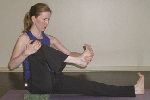 7) Hip Joint Rotation: Hold your right foot with your left hand and use your right hand to cradle your right knee. Flex your right foot to help protect the knee. Move the knee in big circles so that you can feel the hip joint being rotated. Do ten times in each direction. Switch sides and repeat.
7) Hip Joint Rotation: Hold your right foot with your left hand and use your right hand to cradle your right knee. Flex your right foot to help protect the knee. Move the knee in big circles so that you can feel the hip joint being rotated. Do ten times in each direction. Switch sides and repeat.
 8) Full Butterfly: Sit on the floor, or if your lower back tends to round backward, sit on a cushion to raise your hips. Bring your feet together and in, as close to your groin as you can. Keep your feet pressing together, widening the distance between the knees. Use your hands to press the knees down, and release them, allowing them to bounce up. Repeat bouncing the knees twenty times.
8) Full Butterfly: Sit on the floor, or if your lower back tends to round backward, sit on a cushion to raise your hips. Bring your feet together and in, as close to your groin as you can. Keep your feet pressing together, widening the distance between the knees. Use your hands to press the knees down, and release them, allowing them to bounce up. Repeat bouncing the knees twenty times.

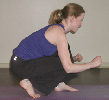
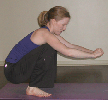 9) Crow Walking: This is the most challenging action of the series. Squat with your feet either flat on the floor, or stay on your toes if you can’t easily get your heels down. Now, keeping your butt near your heels, walk. Do this for a short time. As an option, you can try to touch your knees to the floor with each step. Crow Walking is an excellent preparation for the sitting meditation postures. Dr. Motoyama also mentions that Crow Walking can relieve constipation: drink two glasses of water, walk for a minute, drink another two glasses and walk for another minute. Your constipation should pass if you do this three or four times.
9) Crow Walking: This is the most challenging action of the series. Squat with your feet either flat on the floor, or stay on your toes if you can’t easily get your heels down. Now, keeping your butt near your heels, walk. Do this for a short time. As an option, you can try to touch your knees to the floor with each step. Crow Walking is an excellent preparation for the sitting meditation postures. Dr. Motoyama also mentions that Crow Walking can relieve constipation: drink two glasses of water, walk for a minute, drink another two glasses and walk for another minute. Your constipation should pass if you do this three or four times.
(Next: Upper Body Pawanmuktasana )
